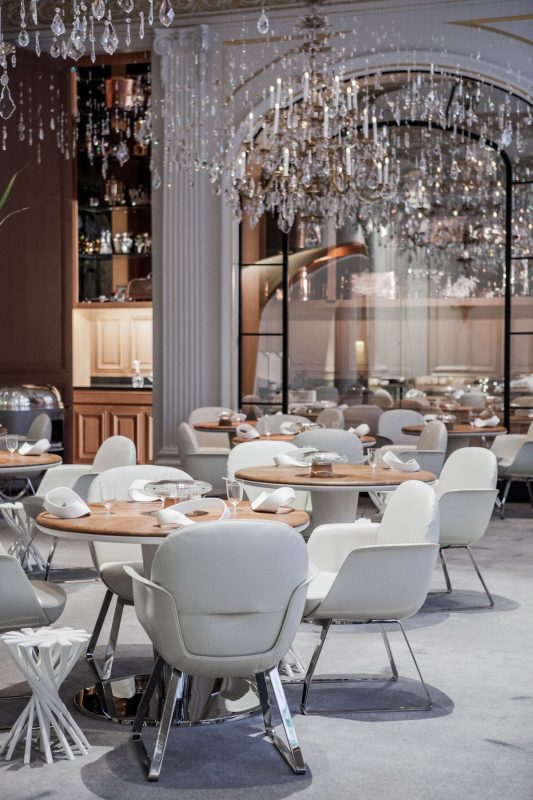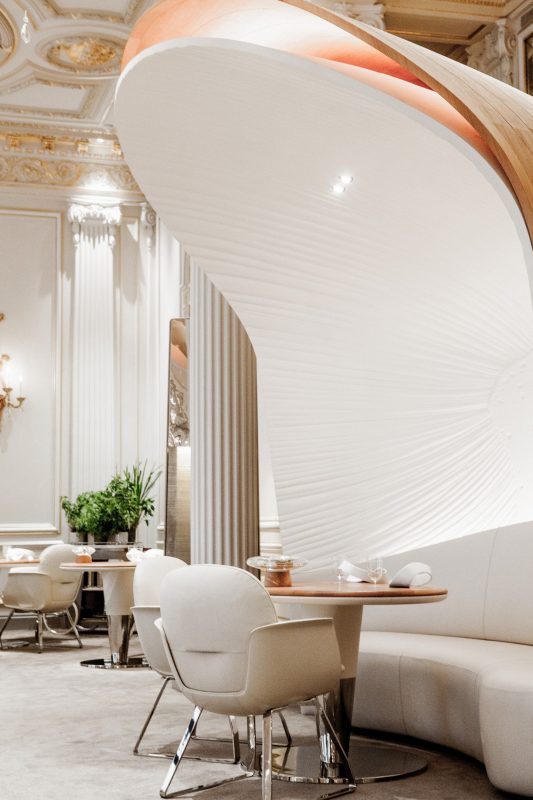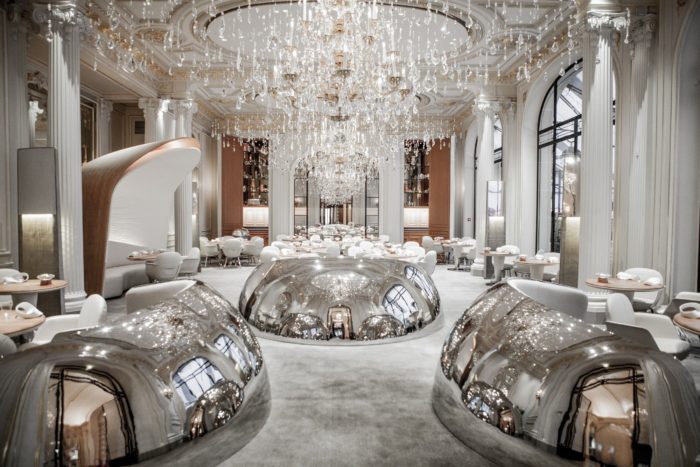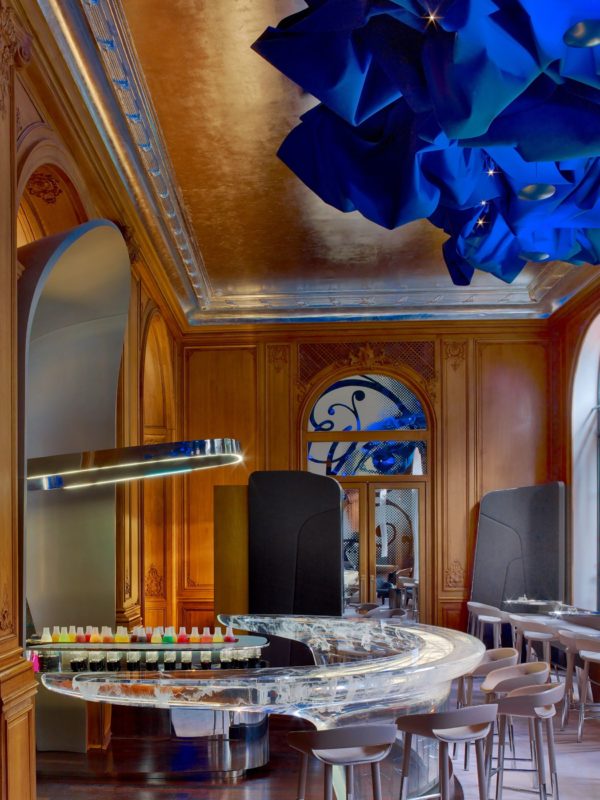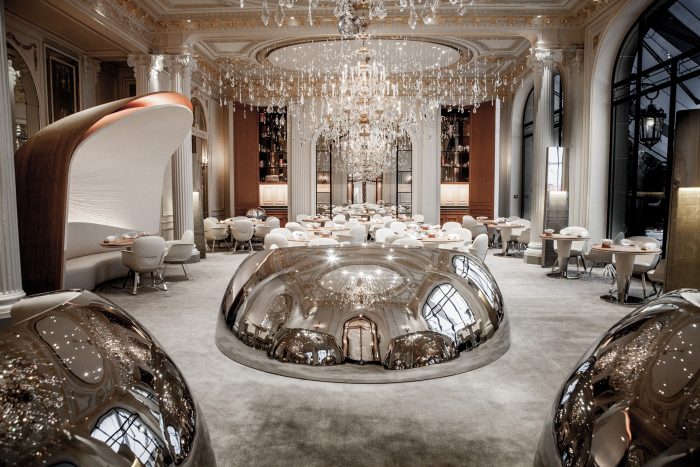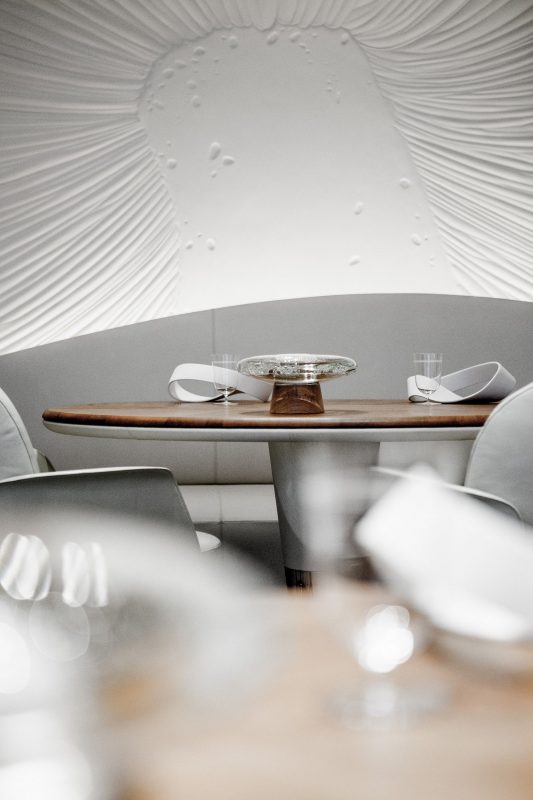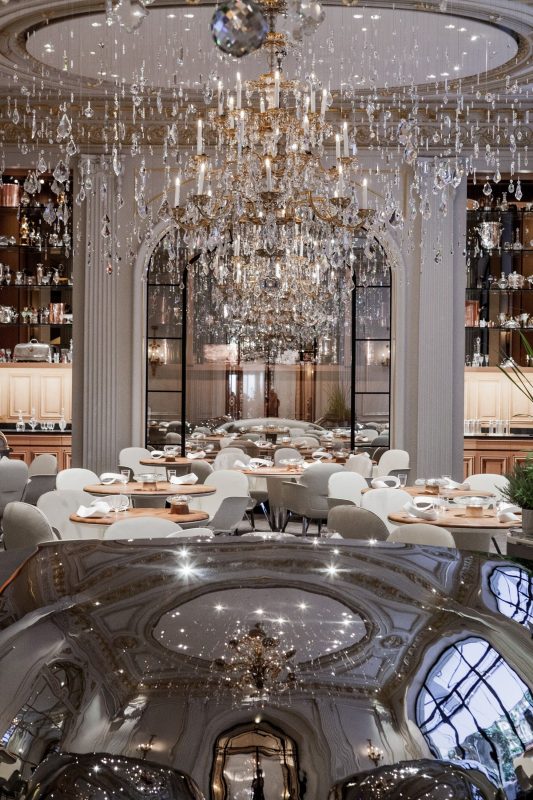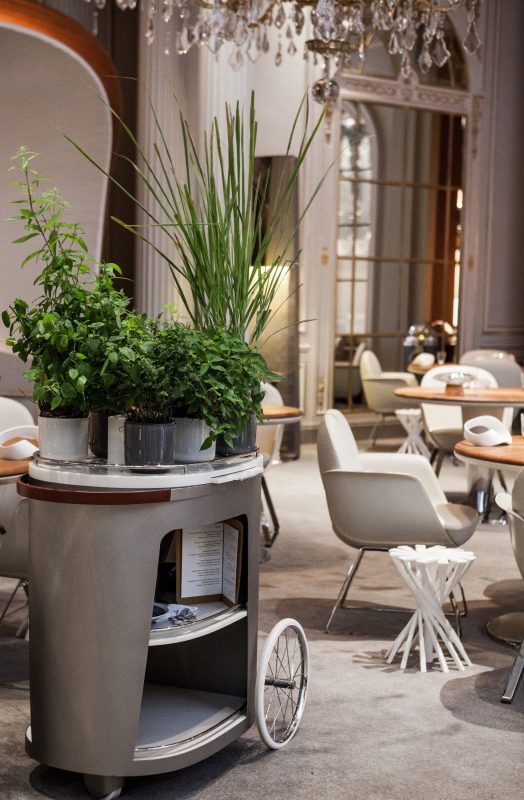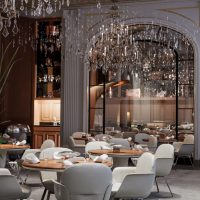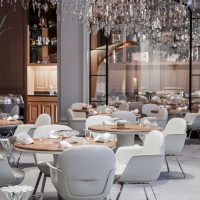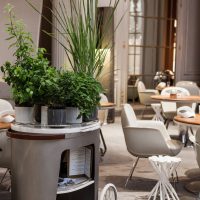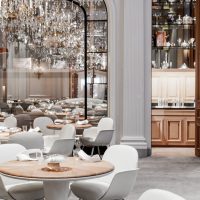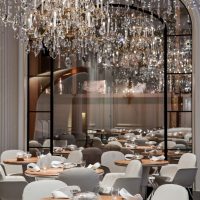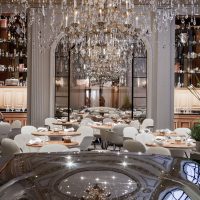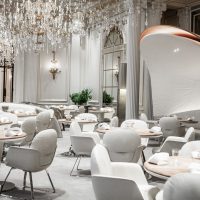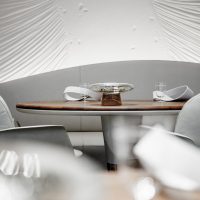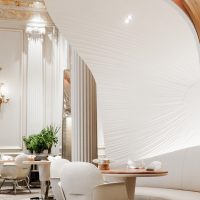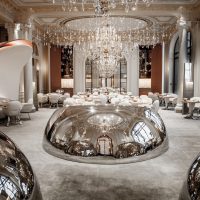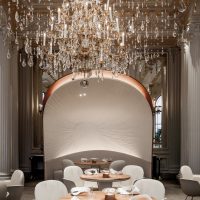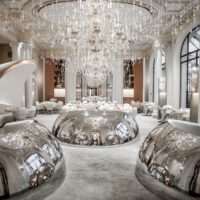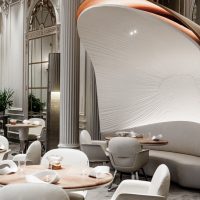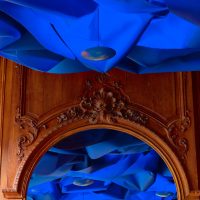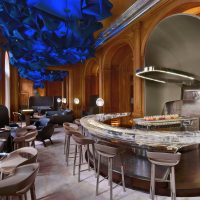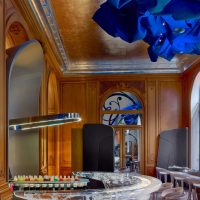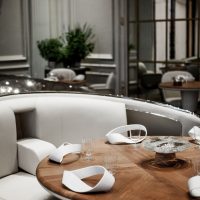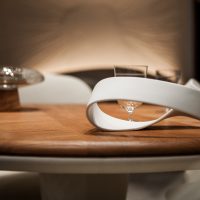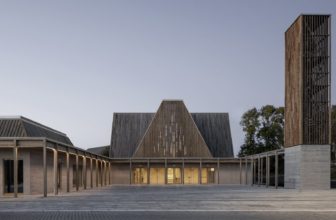Plaza Hotel Athénée – An haute-cuisine restaurant A fantastical bar
The bars and restaurants of classic luxury hotels are the focus of attention: places for meeting and for conviviality. The ambiance that they generate is an important part of the international profile of these establishments. To create a brand new look for the bar and restaurant at the Plaza Athénée in Paris, François Delahaye and Alain Ducasse called once again on the talents of the Jouin Manku design studio, entrusting Patrick Jouin and Sanjit Manku with the interior design of these two spaces. This is the continuation of a longstanding relationship: Patrick Jouin had already worked on the bar and restaurant here on three separate occasions (2000, 2001, 2004), even before his partnership with Sanjit Manku. In 2000, his audacious, contemporary approach propelled the Plaza Athénée bar into the list of the world’s most fashionable addresses.
To create a brand new look for the bar and restaurant at the Plaza Athénée in Paris, François Delahaye and Alain Ducasse called once again on the talents of the Jouin Manku design studio, entrusting Patrick Jouin and Sanjit Manku with the interior design of these two spaces. This is the continuation of a longstanding relationship: Patrick Jouin had already worked on the bar and restaurant here on three separate occasions (2000, 2001, 2004), even before his partnership with Sanjit Manku. In 2000, his audacious, contemporary approach propelled the Plaza Athénée bar into the list of the world’s most fashionable addresses.
In the same way, his sleek decor for the Alain Ducasse restaurant, a majestic interpretation of traditional design codes, has proven highly influential. In 2014 the idea was to push the boundaries even further and propose a totally new vision for these two spaces. Patrick Jouin and Sanjit Manku have conceived a project full of fantasy and wonder, featuring key architectural elements that showcase the savoir-faire of numerous craftspeople. For the Plaza Athénée, Patrick Jouin and Sanjit Manku worked in a way similar to the great fashion designers by surrounding themselves with the most talented craftspeople to make every detail of the bar and restaurant a part of the vision. With the complete support of Alain Ducasse, Patrick Jouin and Sanjit Manku imagined a place with a dramatic and remarkable aesthetic that breaks all the standard rules for 3-star restaurants, enhanced by the work of the exceptionally skilled artisans and craftspeople. A big change in this iteration of the restaurant is that now the room will house not only one, but two restaurants: one ambience for breakfast and another for the haute-cuisine restaurant, differentiated by the tableware, the lighting and totally different spatial organisations.
With the complete support of Alain Ducasse, Patrick Jouin and Sanjit Manku imagined a place with a dramatic and remarkable aesthetic that breaks all the standard rules for 3-star restaurants, enhanced by the work of the exceptionally skilled artisans and craftspeople. A big change in this iteration of the restaurant is that now the room will house not only one, but two restaurants: one ambience for breakfast and another for the haute-cuisine restaurant, differentiated by the tableware, the lighting and totally different spatial organisations. As you enter the restaurant, your attention is drawn to the monumental polished stainless-steel domes on the floor that reflect the thousands of floating crystals of the ceiling chandelier, the only retained element of the restaurant’s former design. These super-scaled and unusual domed shapes form the backrest of banquettes where diners can sit, or screen off groups of tables and chairs. These domes, a witty and elegant twist on the traditional domed plate cover are made by ‘Meilleur Ouvrier de France’* artisans at Matinox and Le Floc’h.
As you enter the restaurant, your attention is drawn to the monumental polished stainless-steel domes on the floor that reflect the thousands of floating crystals of the ceiling chandelier, the only retained element of the restaurant’s former design. These super-scaled and unusual domed shapes form the backrest of banquettes where diners can sit, or screen off groups of tables and chairs. These domes, a witty and elegant twist on the traditional domed plate cover are made by ‘Meilleur Ouvrier de France’* artisans at Matinox and Le Floc’h.
Mirror-polished stainless steel domes
Made by Matinox and Atelier Pierre-Yves Le Floc’h
The manufacture of the three domed structures for the restaurant took 3,500 hours of work for Matinox, the company founded and run by Jean Bertaud, but most particularly for Robert Thébault, artisan metalworker. Matinox is at its core a company that designs and builds handmade, bespoke professional kitchens. From this particular area of expertise they have developed this specialism in artisanal metalworking.
On the left, a striking timber alcove wraps itself around a single table where diners receive a dedicated service and benefit from greater privacy. The outside of the alcove is in unfinished timber, made of strips of curved oak joined together in a shape somewhat reminiscent of the hull of a fishing boat. This piece of ‘micro-architecture’ gives a simple material –wood– a theatrical presence within the overall decor. At the same time it highlights the overall character of the project, which places itself somewhere between refined simplicity and elegant authenticity. Nestled inside the wood shell is a leather banquette that fills the width of the alcove while the alcove’s inner surface of moulded plaster is finished with a surprising motif: the imprint of the restaurant’s old screens, that were decorated with embroidered details of vegetables. Like spirits of the past, their stylised trace remains.
Leather upholstery
Made by Atelier Pierre Yves Le Floc’h
All of the leather upholstery in the restaurant has been carried out by Pierre-Yves Le Floc’h, ‘Compagnon du Devoir’ and ‘Meilleur Ouvrier de France’, a contemporary upholsterer based in Vannes. At his studio he perpetuates disappearing traditional methods of furniture upholstery, decorating seats, desks or any other piece of furniture, with leather. He used these techniques to upholster the banquettes that are part of the restaurant’s dome structures.
In detail / The ADPA restaurant
A thread linking the history of the Plaza Athénée and the new restaurant is Patrick Jouin and Sanjit Manku’s redesign of the service trolleys. To the existing trolleys – very proper objects and a particularly traditional feature of the gastronomic world – the designers have added a touch of mischievous humour, making them more casual, with white, spoked wheels like those on a bicycle. All of the technical parts and the trays have been redesigned in stainless steel, the silver domed plate-cover has been conserved in its original state.
Patrick Jouin and Sanjit Manku have created four luminous and intriguing screens that are used to structure the restaurant space. Built by Rinck and using the same woven metal fabric Patrick Jouin had used for the restaurant’s curtains during a previous re-fit, the screens’ uppermost section is a polished stainless steel ‘mirror’, whose reflections make the space feel larger.
The ADPA restaurant / In detail
All the items above are clearly visible in the day, but at night the room reveals a secret. The wall at the end of the restaurant, with its traditional wall sconces and large mirror, begins to open. Cleverly hidden on both sides are full height doors that open to reveal wooden lined chef’s cabinet of treasures: a display of objects illustrating the history of the art of tableware. Mixing pieces drawn from Alain Ducasse’s personal collection with pieces chosen to represent the most important French manufacturers (Christofle, Saint Louis…) this treasure chest is a conversation piece and a wonderful detail. Lit from inside so that also complements the light emanating from the screens, this cabinet of curiosities is only visible to Alain Ducasse at le Plaza Athenée diners, because in the mornings with the lights extinguished and the doors closed the contents are hidden behind one-way mirrored glass. Chairs
Chairs
Made by Poliform
The dining chairs were all made by Italian manufacturer Poliform. One of the most important manufacturers in the furniture sector, the company was founded in 1970, developing out of an artisanal business originally established in 1942. Poliform marries the high standards of an industrial scale manufacturer with an emphasis on comfort, to produce furniture of a particularly high quality.. The cabinet of curiosities
The cabinet of curiosities
Made by Lallier
The cabinet of curiosities was made by Lallier, the company run by Jean-Marc Bret. Specialists in carpentry for interior design and decoration since 1888, Lallier continues to evolve and adapt to new technologies and materials while maintaining the important traditions of French carpentry and cabinetmaking.
Project Info:
Architects: Patrick Jouin
Location: France,Angers
Discipline: Interior
Program: Bars,Hotels
Construction year: 2000
Photographer: Pierre Monetta
- Photography by Pierre Monetta
- Photography by Pierre Monetta
- Photography by Pierre Monetta
- Photography by Pierre Monetta
- Photography by Pierre Monetta
- Photography by Pierre Monetta
- Photography by Pierre Monetta
- Photography by Pierre Monetta
- Photography by Pierre Monetta
- Photography by Pierre Monetta
- Photography by Pierre Monetta
- Photography by Pierre Monetta
- Photography by Pierre Monetta
- Photography by Pierre Monetta
- Photography by Pierre Monetta
- Photography by Pierre Monetta
- Photography by Pierre Monetta
- Photography by Pierre Monetta


